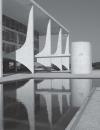Abstract
This article shows the Brazilian panorama of modern architecture based on three examples: Brasilia, Sao Paulo, and Curitiba. These examples represent observation laboratories among the modernist city, the extrapolated metropolis and the traditional city. Brasilia, Sao Paulo and Curitiba reflect the different urban and architectural realities in Brazil since 1960. The capital of the country, opened in 1960, was considered the chimera of modern urbanism. The Athens Letter, created half century ago, gave the guidelines for the organization of this city, in which the urban vitality is still surprising. Sao Paulo, the chaotic industrial metropolis, cannot find the way to resolve its urban problems; nonetheless is the scenario for an architectural vanguard that masters the Brazilian picture between the years of 1960 and 1970. Curitiba, the model city, emerges like a paradigm in urban planning in the 70s. This is the real city where a non-modern planning discovers solutions for the traditional city.Apuntes is registered under a Creative Commons Attribution 4.0 International Public License. Thus, this work may be reproduced, distributed, and publicly shared in digital format, as long as the names of the authors and Pontificia Universidad Javeriana are acknowledged. Others are allowed to quote, adapt, transform, auto-archive, republish, and create based on this material, for any purpose (even commercial ones), provided the authorship is duly acknowledged, a link to the original work is provided, and it is specified if changes have been made. Pontificia Universidad Javeriana does not hold the rights of published works and the authors are solely responsible for the contents of their works; they keep the moral, intellectual, privacy, and publicity rights.
Approving the intervention of the work (review, copy-editing, translation, layout) and the following outreach, are granted through an use license and not through an assignment of rights. This means the journal and Pontificia Universidad Javeriana cannot be held responsible for any ethical malpractice by the authors. As a consequence of the protection granted by the use license, the journal is not required to publish recantations or modify information already published, unless the errata stems from the editorial management process. Publishing contents in this journal does not generate royalties for contributors.


